Monthly Archives: March 2021

 My niece, Liz Masterson is a Journalism teacher at Kelly Walsh High School in Casper, Wyoming, and she is loved by all of her students. Being a teacher is a big responsibility. There is no such thing as a 9 to 5 teaching job. At night, there are papers to grade, lesson plans to prepare, and if you are Liz, there is also photographing every event that takes place at the school. There are times that she misses out on family events because of the workload she carries. Of course, like all teachers, Liz went through the Covid Online School Year, and like most teachers, felt like the students learned almost nothing during the online experience. Liz has been and strives to be an excellent teacher, and anyone who knows her, knows she is a great success. Liz may have faced some unusual methods of doing her job this past year, but she is still a devoted teacher. Her students become her friends for life, and continue to share the events of their lives with her. It’s because they know a teacher who cares when they see one. There is nothing fake about Liz. She genuinely cares about her students, past, present, and yes, even future.
My niece, Liz Masterson is a Journalism teacher at Kelly Walsh High School in Casper, Wyoming, and she is loved by all of her students. Being a teacher is a big responsibility. There is no such thing as a 9 to 5 teaching job. At night, there are papers to grade, lesson plans to prepare, and if you are Liz, there is also photographing every event that takes place at the school. There are times that she misses out on family events because of the workload she carries. Of course, like all teachers, Liz went through the Covid Online School Year, and like most teachers, felt like the students learned almost nothing during the online experience. Liz has been and strives to be an excellent teacher, and anyone who knows her, knows she is a great success. Liz may have faced some unusual methods of doing her job this past year, but she is still a devoted teacher. Her students become her friends for life, and continue to share the events of their lives with her. It’s because they know a teacher who cares when they see one. There is nothing fake about Liz. She genuinely cares about her students, past, present, and yes, even future.



While teaching is her passion, as well as her career, Liz is also an excellent daughter. Her mom, my sister Cheryl Masterson, raised Liz and her four siblings alone, and they are very loyal to her. Liz often does little things to make her mom’s life easier. After the recent two feet of snow we received, bringing to a standstill, much of Casper, Liz went over to her mom’s house, and dug her out of the snowdrift her house and yard were buried in. It was a massive undertaking, but Liz persevered and got the job done. Her mom still couldn’t get out, until the streets were cleared, and thankfully was able to work from home for a few days. Then, when the roads were open again Cheryl, like everyone else in town was able to get back to normal life again. Of course, Liz had to dig her own house out before she could come and dig her mom out, so she got a double dose of show removal.
Liz is the mother to five fur babies, three dogs, named Buffy, Luka, and Scout, and two cats, named Kitty and Izzy. They 
 Love her to pieces…and the feeling is mutual. I often see Liz out walking her dogs…often in a stroller-cart because they get too tired or rowdy when she walks them. They just get excited and want to run in circles around her. To the casual witness, it’s quite comical, but to Liz, it’s pretty frustrating. Sometimes she just walks them one at a time…just for the sanity. She loves her babies, but it does make for a crazy live. Today is Liz’s birthday. Happy birthday Liz!! Have a great day!! we love you!!
Love her to pieces…and the feeling is mutual. I often see Liz out walking her dogs…often in a stroller-cart because they get too tired or rowdy when she walks them. They just get excited and want to run in circles around her. To the casual witness, it’s quite comical, but to Liz, it’s pretty frustrating. Sometimes she just walks them one at a time…just for the sanity. She loves her babies, but it does make for a crazy live. Today is Liz’s birthday. Happy birthday Liz!! Have a great day!! we love you!!
 Apartment living is something many people do, and while they might dream of a house, or even have one, there can be reasons for having an apartment too. The oilfield would be one example of the need for a second place to live. Often, oil field workers must travel to the worksite. Once there, they have to stay there for a time, because traveling to and from home twice a day is just not feasible. Many oilfield companies provide living quarters for their employees. Sometimes it is a local motel, sometimes apartments, and sometimes, as with off shore drilling operations, companies must get innovative.
Apartment living is something many people do, and while they might dream of a house, or even have one, there can be reasons for having an apartment too. The oilfield would be one example of the need for a second place to live. Often, oil field workers must travel to the worksite. Once there, they have to stay there for a time, because traveling to and from home twice a day is just not feasible. Many oilfield companies provide living quarters for their employees. Sometimes it is a local motel, sometimes apartments, and sometimes, as with off shore drilling operations, companies must get innovative.
Some living quarters for oil field workers is quite a bit different than  others. The Edda oil rig in the Ekofisk field, 235 miles east of Dundee, Scotland had just such an unusual housing arrangement for the employees who worked on the Edda oil rig. The Alexander Kielland platform was a floating apartment unit that housed 208 people. The floating apartment complex was located in the North Sea. The majority of the Phillips Petroleum workers were from Norway, but a few were American and British. The platform was held up by two large pontoons. It had bedrooms, kitchens, and lounges, and provided a place for workers to spend their time when not working. It was truly a comfortable home away from home…for the most part.
others. The Edda oil rig in the Ekofisk field, 235 miles east of Dundee, Scotland had just such an unusual housing arrangement for the employees who worked on the Edda oil rig. The Alexander Kielland platform was a floating apartment unit that housed 208 people. The floating apartment complex was located in the North Sea. The majority of the Phillips Petroleum workers were from Norway, but a few were American and British. The platform was held up by two large pontoons. It had bedrooms, kitchens, and lounges, and provided a place for workers to spend their time when not working. It was truly a comfortable home away from home…for the most part.
On March 30, 1980, at about 6:30pm most of the residents were in the platform’s small theater watching a movie. There was a storm brewing, but although there were gale conditions in the North Sea that evening, no one was expecting that a large wave would collapse and capsize the platform. Everything happened very fast. 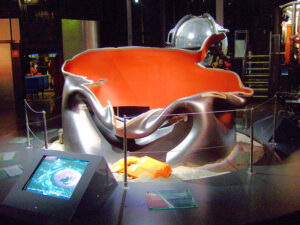 The wave hit, and things began to collapse. Within 15 minutes of the collapse, the floating apartment complex had capsized. It was so fast that many of the workers were unable to make it to the lifeboats. The Royal Air Force of Great Britain and Norwegian military both immediately sent rescue helicopters, but the poor weather made it impossible for them to help. Of the 208 people onboard, 123 drowned. The nightmare scenario seemed impossible, but a subsequent investigation revealed that there was a previously undetected crack in one of main legs of the platform. That had caused the structure’s disastrous collapse. The Alexander Kielland sat in the water for three years before it was salvaged.
The wave hit, and things began to collapse. Within 15 minutes of the collapse, the floating apartment complex had capsized. It was so fast that many of the workers were unable to make it to the lifeboats. The Royal Air Force of Great Britain and Norwegian military both immediately sent rescue helicopters, but the poor weather made it impossible for them to help. Of the 208 people onboard, 123 drowned. The nightmare scenario seemed impossible, but a subsequent investigation revealed that there was a previously undetected crack in one of main legs of the platform. That had caused the structure’s disastrous collapse. The Alexander Kielland sat in the water for three years before it was salvaged.
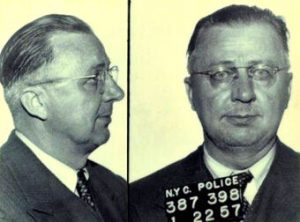 These days, it seems we are hearing about mass shootings, terrorist-type attacks, bombings, and riots, all because people are “disgruntled” about something. It’s like everyone somehow thinks that the best solution to any disagreement is violence. Well, while this type of behavior is not new, it does seem to be happening more and more. Nevertheless, some of the worst attacks weren’t recent, but actually further back in our not so distant past.
These days, it seems we are hearing about mass shootings, terrorist-type attacks, bombings, and riots, all because people are “disgruntled” about something. It’s like everyone somehow thinks that the best solution to any disagreement is violence. Well, while this type of behavior is not new, it does seem to be happening more and more. Nevertheless, some of the worst attacks weren’t recent, but actually further back in our not so distant past.
On March 29, 1951, out of the blue, a homemade bomb exploded at Grand Central Station in New York City. While there were no injuries, commuters were quite startled. It wasn’t as easy to make a homemade bomb in 1951, because the internet didn’t exist. It’s not that the internet is the only place to find instructions on bombmaking, but it has made the process easier. Over the next few months, five more bombs were found at landmark sites around New York, including the public library. Authorities realized that this new wave of terrorist acts was the work of a man they dubbed the Mad Bomber.
This was not the first time New York had been visited by the so-called Mad Bomber. On November 16, 1940, a 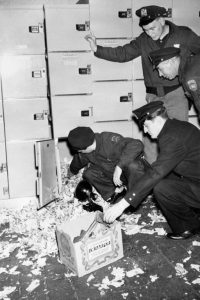 pipe bomb was left in the Edison building with a note that read, “Con Edison crooks, this is for you.” It was a clear indicator of a man who was “disgruntled” with Con Edison over something. What it was all about remained to be seen. Throughout 1941, more bombs were recovered , each more powerful than the last, until in December, the Mad Bomber sent a note stating, “I will make no more bomb units for the duration of the war.” What a strange turn of events. The Mad Bomber was…a patriot!! His letter also stated that Con Edison, New York’s electric utility company, would be brought to justice in due time. I’m not sure whether the people should have been praying for the war to continue, so that the bomber would stop bombing New York; or praying for the horrific war to come to an end. No matter what else he was, the Mad Bomber was not a liar. He made good on his promise, although he sent threatening notes to the press periodically. The year 1951 brought about a flurry of activity, then the Mad Bomber stopped again until 1954 when a bomb went off at Radio City Music Hall. Then in 1955, the Mad Bomber hit Grand Central Station, Macy’s, the RCA building, and the Staten Island Ferry.
pipe bomb was left in the Edison building with a note that read, “Con Edison crooks, this is for you.” It was a clear indicator of a man who was “disgruntled” with Con Edison over something. What it was all about remained to be seen. Throughout 1941, more bombs were recovered , each more powerful than the last, until in December, the Mad Bomber sent a note stating, “I will make no more bomb units for the duration of the war.” What a strange turn of events. The Mad Bomber was…a patriot!! His letter also stated that Con Edison, New York’s electric utility company, would be brought to justice in due time. I’m not sure whether the people should have been praying for the war to continue, so that the bomber would stop bombing New York; or praying for the horrific war to come to an end. No matter what else he was, the Mad Bomber was not a liar. He made good on his promise, although he sent threatening notes to the press periodically. The year 1951 brought about a flurry of activity, then the Mad Bomber stopped again until 1954 when a bomb went off at Radio City Music Hall. Then in 1955, the Mad Bomber hit Grand Central Station, Macy’s, the RCA building, and the Staten Island Ferry.
The police faced a stalemate when it came to finding the Mad Bomber, but finally, an investigative team working for Con Ed tracked him down. Looking through their employment records, they found that George Peter Metesky had been a disgruntled ex-employee since an accident in 1931. Metesky was furious that Con Ed refused to pay disability benefits and, in the end, resorted to terrorism as his revenge. This seems to be the  reason a lot of ex-employees resort to violence of some form. They think that because they were wronged, people must die to pay for the injustice they are feeling, never understanding that the people they injure or kill, were completely innocent in that matter. Really!! How dare they do such a thing?
reason a lot of ex-employees resort to violence of some form. They think that because they were wronged, people must die to pay for the injustice they are feeling, never understanding that the people they injure or kill, were completely innocent in that matter. Really!! How dare they do such a thing?
Metesky, had been a rather mild-mannered man, prior to the accident. It was his fury at his injustice that turned him into a monster. Metesky was found to be living with his sisters in Connecticut. Following his capture and trial, he was sent to a mental institution in April 1957 where he stayed until his release in 1973. He died in 1994.
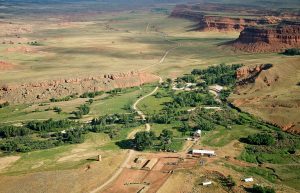 Tucked away in a sleepy area of Wyoming, lies an Old West outlaw hideout. It is located in a remote pass in the Big Horn Mountains of Johnson County, Wyoming. It’s called Hole-In-The-Wall, and in reality, it is anything, but a hole in a wall. The nearest town is Kaycee, Wyoming, population of 274. It is 24.9 miles away, but it will take you 53 minutes to get there by car.
Tucked away in a sleepy area of Wyoming, lies an Old West outlaw hideout. It is located in a remote pass in the Big Horn Mountains of Johnson County, Wyoming. It’s called Hole-In-The-Wall, and in reality, it is anything, but a hole in a wall. The nearest town is Kaycee, Wyoming, population of 274. It is 24.9 miles away, but it will take you 53 minutes to get there by car.
The hideout gets its name from the fact that there is a large break in an otherwise full wall of red sandstone. I suppose you could call it a hole in the wall, but it’s rather large to be called a hole. When I think of a hole in a wall, I picture a small hole…man-sized where a person could sneak in, and possibly even hide the hole with a tumbleweed, but that is not it at all. The remoteness of the area, and the wall made it almost impossible for lawmen to get to the hideout without being seen. The hideout was used 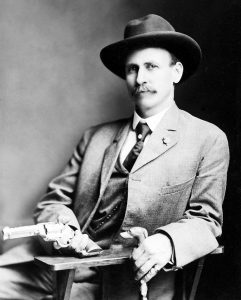 in the late 19th century by the Hole-in-the-Wall Gang, a group of cattle rustlers and other outlaws that included the Logan brothers, Kid Curry, Black Jack Ketchum, and Butch Cassidy’s Wild Bunch. Butch Cassidy, the Sundance Kid, and other desperados met at a log cabin in the Hole-in-the-Wall country. The cabin was built in 1883 by a man named Alexander Ghent.
in the late 19th century by the Hole-in-the-Wall Gang, a group of cattle rustlers and other outlaws that included the Logan brothers, Kid Curry, Black Jack Ketchum, and Butch Cassidy’s Wild Bunch. Butch Cassidy, the Sundance Kid, and other desperados met at a log cabin in the Hole-in-the-Wall country. The cabin was built in 1883 by a man named Alexander Ghent.
The lawmen tried a number of way to learn more about the site, including the one Pinkerton National Detective Agency detective, Charlie Siringo wrote about, “I started for the Big Horn Basin in the vicinity of the Hole-in-the-Wall in northern Wyoming. I had received instructions from Assistant Superintendent Curran to go up there and get in with the friends of the ‘Wild Bunch’, and learn their secrets.” He like so many more was unsuccessful. No lawmen ever successfully entered the Hole-In-The-Wall to capture outlaws during its more than fifty years of active existence, nor were any lawmen attempting to infiltrate it by use of undercover techniques successful.
The area was remote and secluded, easily defended because of its narrow passes, and impossible for lawmen to 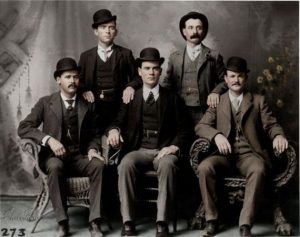 approach without alerting the outlaws. From the late 1860s to around 1910, the pass was used frequently by numerous outlaw gangs. At its height, it featured several cabins that gangs used to lie up during the harsh Wyoming winters, and it had a livery stable, corral, livestock, and supplies, with each gang contributing to the upkeep of the site. While several gangs were there at any given time, they were able to keep their plans and schemes to their own gang. I suppose the was some honor among thieves after all. Eventually, the use of this site faded into history, with gangs using it less frequently. Of course, now it is just another historic site, but some of the buildings are still there.
approach without alerting the outlaws. From the late 1860s to around 1910, the pass was used frequently by numerous outlaw gangs. At its height, it featured several cabins that gangs used to lie up during the harsh Wyoming winters, and it had a livery stable, corral, livestock, and supplies, with each gang contributing to the upkeep of the site. While several gangs were there at any given time, they were able to keep their plans and schemes to their own gang. I suppose the was some honor among thieves after all. Eventually, the use of this site faded into history, with gangs using it less frequently. Of course, now it is just another historic site, but some of the buildings are still there.

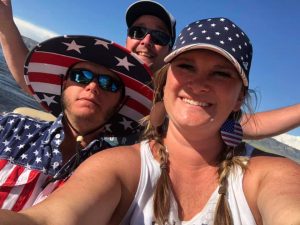 My niece, Amanda Reed is a non-stop girl. Winter, Spring, Summer, or Fall, she and her family go, go, go!! Of course, they work and do all the other normal things, but on the weekends, they are so active that it would make most people exhausted, and I am a really active person, so for me to say that, is really saying something. I don’t like Winter, however, so most of my Winter activity is indoors. Amanda…well, she doesn’t mind the snow. She is out there hiking, snowshoeing, snowmobiling, four-wheeling…you name it. Nothing slows this family down. The like to live life to the fullest. Its a great way to be.
My niece, Amanda Reed is a non-stop girl. Winter, Spring, Summer, or Fall, she and her family go, go, go!! Of course, they work and do all the other normal things, but on the weekends, they are so active that it would make most people exhausted, and I am a really active person, so for me to say that, is really saying something. I don’t like Winter, however, so most of my Winter activity is indoors. Amanda…well, she doesn’t mind the snow. She is out there hiking, snowshoeing, snowmobiling, four-wheeling…you name it. Nothing slows this family down. The like to live life to the fullest. Its a great way to be.
Amanda works at a bank in Rawlins, Wyoming, as a BSA Agent. For any who don’t know, that is an agent who keeps records and files reports that are highly useful in criminal, tax, and regulatory matters. The documents she files under the BSA requirements are heavily used by law enforcement agencies, both domestic and international to identify, detect, and deter money laundering, whether it is in furtherance of a criminal enterprise, terrorism, tax evasion, or other unlawful activity. That is to say that she protects the bank, and the rest of us from thieves who would destroy our economy by the introduction of fake money with no value.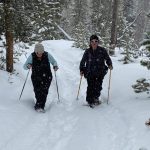
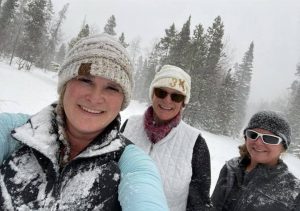
The two most important people in Amanda’s life, are her partner, Sean Mortenson and her daughter Jadyn Mortensen. Amanda is a horse girl’s mom, and is there to encourage Jadyn every step of the way. f course, it doesn’t take much encouragement, because Jadyn loves her horse, and riding is something she would rather do over just about anything in the world. Still, there are good days and bad days in any sport, and Amanda is one of Jadyn’s biggest cheerleaders. She also is a sports daughter, encouraging her mom, Deb Lucero in her hiking. They recently went on a winter snowshoe hike in the mountains, and had a great time. They have a lot more gumption than I do. The cold/snow part of that would be a big problem to me, but not for these girls or for Debbie Morgan-Fall, who went along.
When she is not working at her very serious job, Amanda, her family, and friends like to kick back, and be hilariously funny. In fact, they are among the funniest people I know of. These people have no problem with 
 acting goofy, dressing funny, or funny comments. They love to laugh and make each other laugh, and that’s what it’s all about. This group of friends love to get together and have a great time. They go to the lake, the mountain, or just hang out at someone’s house. They love time together, and refuse social distancing…like most of us. Togetherness, yep that’s it. Today is Amanda’s birthday. Happy birthday Amanda!! Have a great day!! We love you!!
acting goofy, dressing funny, or funny comments. They love to laugh and make each other laugh, and that’s what it’s all about. This group of friends love to get together and have a great time. They go to the lake, the mountain, or just hang out at someone’s house. They love time together, and refuse social distancing…like most of us. Togetherness, yep that’s it. Today is Amanda’s birthday. Happy birthday Amanda!! Have a great day!! We love you!!
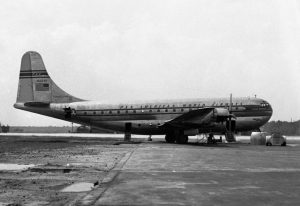 Pan American World Airways Flight 845/26, a Boeing 377 Stratocruiser, Clipper United States, N1032V departed from Seattle-Tacoma Airport (SeaTac) on March 26, 1955 at 8:15am…a Saturday morning, destined for Sydney, Australia, with stops at Portland, Oregon and Honolulu, Hawaii. Following its stop in Portland (PDX), the plane took off at 10:21am, with a crew of 8 and 15 passengers on board. It looked to be an easy flight to Hawaii, with plenty of onboard staff to make the trip enjoyable for the passengers. The plane was piloted by Captain Herman Joslyn, with First Officer Angus Gustavus Hendrick Jr; Second Officer Michael Kerwick; Flight Engineer Donald Read Fowler; and Assistant Flight Engineer Stuart Bachman. In the passenger cabin were Purser Natalie Parker, Stewardess Elizabeth Thompson, and Steward James Peppin.
Pan American World Airways Flight 845/26, a Boeing 377 Stratocruiser, Clipper United States, N1032V departed from Seattle-Tacoma Airport (SeaTac) on March 26, 1955 at 8:15am…a Saturday morning, destined for Sydney, Australia, with stops at Portland, Oregon and Honolulu, Hawaii. Following its stop in Portland (PDX), the plane took off at 10:21am, with a crew of 8 and 15 passengers on board. It looked to be an easy flight to Hawaii, with plenty of onboard staff to make the trip enjoyable for the passengers. The plane was piloted by Captain Herman Joslyn, with First Officer Angus Gustavus Hendrick Jr; Second Officer Michael Kerwick; Flight Engineer Donald Read Fowler; and Assistant Flight Engineer Stuart Bachman. In the passenger cabin were Purser Natalie Parker, Stewardess Elizabeth Thompson, and Steward James Peppin.
The flight was proceeding as normal, until it hit 10,000 feet, at which point a severe vibration lasting 5 to 8 seconds began. The Number 3 engine, which is on the right side, on the inside, suddenly ripped away from the starboard wing. The damage to the wing caused severe shaking. At the same time, the nose pitched down and the airspeed increased rapidly. Captain Joslyn immediately reduced engine power slow the plane down some, but they were losing altitude rapidly, quickly dropping by 5,000 feet. The damage cause by the engine ripping away included damage to the engines’ electrical system, and the flight engineer was not able to increase power on the remaining three engines. Without the added power on the remaining engines, the Stratocruiser was too heavy at this early stage in the flight to maintain its altitude. She still had too much fuel onboard to compensate. The Stratocruiser was doomed, and there was nowhere to land.
The flight crew ditched the Stratocruiser into the north Pacific Ocean at 11:12am, approximately 35 miles west of the Oregon coastline. The conditions were ideal for ditching, with smooth seas and little wind, but it was a hard impact. As the plane hit the water, seats were torn loose, and several occupants were injured. Nevertheless, no one was killed and evacuation began immediately with the inflation of all three life rafts. The water temperature was 47° F, so getting out of the water was essential. Soon after the crash, a North American Aviation F-86F Sabre flown by Captain W L Parks, 142nd Fighter Interceptor Group, Oregon Air National Guard, located the scene of the ditching. When he saw the smoke flares that had been released, he was able to see the two life rafts tied together. A Lockheed Constellation also rushed to the scene from the south. After confirming that Air Force rescue aircraft were on the way, Captain Parks returned to Portland, because he was low on fuel.
Among the injured was the airliner’s purser, Natalie Parker, who had been assisting passengers with their life vests and seat belts when the airliner hit the water. Because she was standing in the aisle, she was thrown forward, knocking down five rows of seats as she hit them. She was badly bruised and suffering from shock. Nevertheless, Parker assisted the passengers in abandoning the sinking Stratocruiser. When everyone was off, she enter the water and saw that some of the injured had begun to drift away. In an amazing act of bravery and duty, and suffering from shock, Parker swam out and towed the only seriously injured passenger to the nearest raft, some 200 feet away. The Stratocruiser floated for an amazing 20 minutes before sinking. While all survived the impact, four of the 23 persons on board, passengers John Peterson, David Darrow, First Officer Hendrick, and Flight Engineer Fowler, died of injuries and exposure. The survivors were rescued after two hours by the crew of USS Bayfield (APA-33), a United States Navy attack transport.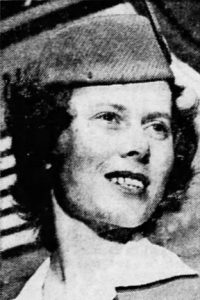
During the Civil Aeronautics Board hearings into the accident, Vice Chairman Joseph P. Adams commended Natalie Parker, the flight’s purser, “. . . all of us feel inspired that a fellow citizen, or just a fellow human being, can rise to such an occasion in the manner in which you did. It is most commendable, Miss Parker.” The exact cause of the loss of the Stratocruiser was not fully determined, because the engine and propeller were not recovered. Th investigation assumed that the most likely cause was a fracture of a propeller blade resulting in a severely unbalanced condition, causing the violent separation of the engine from the wing. This was the fifth time that a Boeing 377 Stratocruiser had lost an engine following the failure of a hollow-steel Hamilton Standard 2J17 propeller blade. Further complicating the matter, was the flight engineer’s attempt to increase the propeller rpm on the three engines simultaneously. That caused an electrical overload occurred which opened the master circuit breaker. This prevented any engine power increase, effectively bringing down the Stratocruiser.
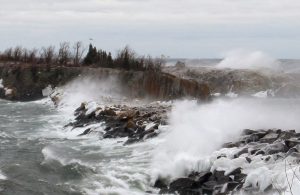
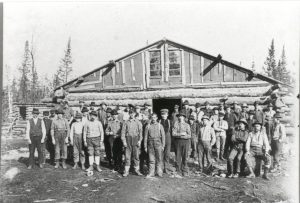 The port city of my birth, Superior, Wisconsin was founded on November 6, 1854 and incorporated March 25 1889. The city’s slogan soon became, “Where Sail Meets Rail,” because it was port connection between the shipping industry and the railroad. Much of Superior’s history parallels its sister city of Duluth’s, but Superior has been around longer than Duluth, which is also known as the Zenith City. Of course, the area had people there before that…there were Ojibwe Indians, and French traders that are known to be in the area in the early 1600s.
The port city of my birth, Superior, Wisconsin was founded on November 6, 1854 and incorporated March 25 1889. The city’s slogan soon became, “Where Sail Meets Rail,” because it was port connection between the shipping industry and the railroad. Much of Superior’s history parallels its sister city of Duluth’s, but Superior has been around longer than Duluth, which is also known as the Zenith City. Of course, the area had people there before that…there were Ojibwe Indians, and French traders that are known to be in the area in the early 1600s.
After the Ojibwe settled in the area and set up an encampment on present-day Madeline Island, the French started arriving. In 1618 voyageur Etienne Brulé paddled along Lake Superior’s south shore where he encountered the Ojibwe tribe, but he also found copper specimens. Brulé went back to Quebec with the copper samples, and a glowing report of the region. French traders and missionaries began settling the area a short time later, and a Lake Superior tributary was named for Brulé. Father Claude Jean Allouez, was one of those missionaries. His is often credited with the development of an early map of the region. Superior’s Allouez neighborhood takes its name from the Catholic missionary. The area was developed quickly after that, and by 1700 the area was crawling with French traders. The French traders developed a good working relationship with the Ojibwe people.
The Ojibwe continued to get along well with the French, but not so much the British, who ruled the area after 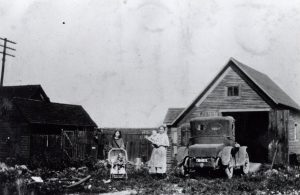
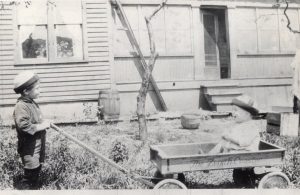 the French, but that ended with the America Revolution and the Treaty of Peace in 1783. The British weren’t as good to the Ojibwe as the French had been. Treaties with the Ojibwe would give more territory to settlers of European descent, and by 1847 the United States had taken control of all lands along Lake Superior’s south shore.
the French, but that ended with the America Revolution and the Treaty of Peace in 1783. The British weren’t as good to the Ojibwe as the French had been. Treaties with the Ojibwe would give more territory to settlers of European descent, and by 1847 the United States had taken control of all lands along Lake Superior’s south shore.
In 1854 the first copper claims were staked at the mouth of the Nemadji River…some say it was actually 1853. The Village of Superior became the county seat of the newly formed Douglas County that same year. The village grew quickly and within two years, about 2,500 people called Superior home. Unfortunately, with the financial panic of 1857, the town’s population stagnated through the end of the Civil War. The building of the Duluth Ship Canal in 1871, which was followed by the Panic of 1873. pretty much crushed Superior’s economic future. Things began to look up when in 1885, Robert Belknap and General John Henry Hammond’s Land and River Improvement Company established West Superior. Immediately they began building elevators, docks, and industrial railroads. In 1890, Superior City and West Superior merged, The city’s population fluctuated, as a boom town will, between 1887 and 1893, and then another financial panic halted progress. Over the years since then, Superior’s population has had it’s ups and down, as has it’s sister city, Duluth, but it has remained about one fourth the size of its twin across the bay.
My great grandparents, Carl and Albertine Schumacher lived in the Goodhue, Minnesota area, when my grandmother Anna was born, but my grandparents Allen and Anna Spencer lived in Superior. That is where my 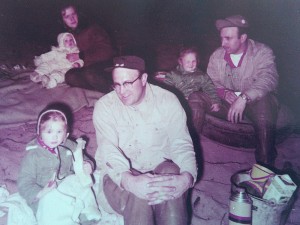
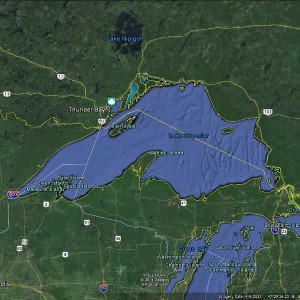 dad, Allen Spencer was born, as were my sister, Cheryl and I. We didn’t live in Superior for all of our lives, just 3 and 5 years, but the area remains in our blood, and in our hearts. It could be partly because of all the trips our family made back to Superior, but I don’t think that’s totally it, because there is just something about knowing that you came from a place, that will always make it special. Superior, Wisconsin is a very special place, that will always be a part of me and my sister, Cheryl too.
dad, Allen Spencer was born, as were my sister, Cheryl and I. We didn’t live in Superior for all of our lives, just 3 and 5 years, but the area remains in our blood, and in our hearts. It could be partly because of all the trips our family made back to Superior, but I don’t think that’s totally it, because there is just something about knowing that you came from a place, that will always make it special. Superior, Wisconsin is a very special place, that will always be a part of me and my sister, Cheryl too.

 Like most kids, after they graduate from high school, my grandnephew, Weston Moore’s mind turned to getting a place of his own. So he found some friends and they got a place in May of 2020. Of course, we all know that 2020 brought with it some hardships in the area of working and spending time with family. While Weston was able to keep working, it just seemed prudent to move back home where he could spend more time with his parents, Machelle and Steve Moore, and his brother, Easton. I think everyone would agree that it was a good idea, especially his family, who all missed him very much. Not to mention the fact that at that time, none of us knew how bad Covid would or would not get, so Machelle ad Steve felt much better having their kids both at home.
Like most kids, after they graduate from high school, my grandnephew, Weston Moore’s mind turned to getting a place of his own. So he found some friends and they got a place in May of 2020. Of course, we all know that 2020 brought with it some hardships in the area of working and spending time with family. While Weston was able to keep working, it just seemed prudent to move back home where he could spend more time with his parents, Machelle and Steve Moore, and his brother, Easton. I think everyone would agree that it was a good idea, especially his family, who all missed him very much. Not to mention the fact that at that time, none of us knew how bad Covid would or would not get, so Machelle ad Steve felt much better having their kids both at home.
Weston had been driving a little car, but during the time he was living on his own, he managed to save enough money to get himself a better vehicle. He knew he wanted an SUV, and had considered a Suburban, but in the end, he purchased a Yukon, which he is very happy with. He found it right there in Powell, and so didn’t have to travel to get it. Now that he has found his dream ride, Weston has begun to get it “tricked out” with a few new 
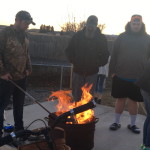 items to make it special. He added LED light strips, subwoofer, amp, stereo, and has a light bar that still needs to be installed. He also put on new brakes and rotors on the back, new tie rods on the front. Even though he has a sound system that could blow out the windows, Weston is very courteous about where he is at and what time it is, so that he doesn’t disturb people. Even his own mom has only heard it a few times. Weston has a big heart and will do anything for anyone!! When his grandma needed a ride to Cody the other day, and his grandpa, who recently had surgery, wasn’t ready for such a trip, Weston volunteered to take her. Of course, on the plus side, he got to drive the new car for a longer distance than just around town. Everybody likes an occasional road trip.
items to make it special. He added LED light strips, subwoofer, amp, stereo, and has a light bar that still needs to be installed. He also put on new brakes and rotors on the back, new tie rods on the front. Even though he has a sound system that could blow out the windows, Weston is very courteous about where he is at and what time it is, so that he doesn’t disturb people. Even his own mom has only heard it a few times. Weston has a big heart and will do anything for anyone!! When his grandma needed a ride to Cody the other day, and his grandpa, who recently had surgery, wasn’t ready for such a trip, Weston volunteered to take her. Of course, on the plus side, he got to drive the new car for a longer distance than just around town. Everybody likes an occasional road trip.
These days, with Covid heading downhill, Weston has started to think about moving out on his own again. He has a couple friends that have recently moved to Montana, and so he is thinking of moving there too. He has begun the job hunting part as well, because he doesn’t want to just move and have no plan. Of course, for his 
 family, this will bring about the whole “missing him” thing again, but Montana isn’t too awfully far away, and they can make some weekend trips to see him. This will be a great new adventure for Weston, and something he will never forget. He might as well take the leap while he is young, knowing that he can always move back to Powell later on if he doesn’t like Montana. And it isn’t so far that he can’t road trip home. I know he will miss his family and cousins, but it will all be a great learning experience too. Today is Weston’s 21st birthday. Happy birthday Weston!! Have a great day!! We love you!!
family, this will bring about the whole “missing him” thing again, but Montana isn’t too awfully far away, and they can make some weekend trips to see him. This will be a great new adventure for Weston, and something he will never forget. He might as well take the leap while he is young, knowing that he can always move back to Powell later on if he doesn’t like Montana. And it isn’t so far that he can’t road trip home. I know he will miss his family and cousins, but it will all be a great learning experience too. Today is Weston’s 21st birthday. Happy birthday Weston!! Have a great day!! We love you!!
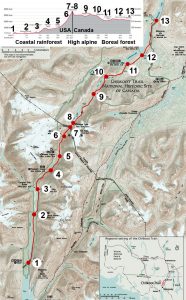 As one who loves to hike, I am always interested in a new trail, whether I will ever get to hike that trail or not. The Chilkoot Trail is a 33 mile trail that travels through the Coast Mountains. The trail travels from Dyea, Alaska, in the United States, to Bennett, British Columbia, in Canada. During the Klondike Gold Rush (1896–1899), the Chilkoot Trail was transformed into a mainstream transportation route to Canada’s interior. The gold rush was primarily focused around Dawson City in Yukon and the Yukon River. While not the easiest trail, the Chilkoot Trail was the most direct, least expensive, and consequently the most popular.
As one who loves to hike, I am always interested in a new trail, whether I will ever get to hike that trail or not. The Chilkoot Trail is a 33 mile trail that travels through the Coast Mountains. The trail travels from Dyea, Alaska, in the United States, to Bennett, British Columbia, in Canada. During the Klondike Gold Rush (1896–1899), the Chilkoot Trail was transformed into a mainstream transportation route to Canada’s interior. The gold rush was primarily focused around Dawson City in Yukon and the Yukon River. While not the easiest trail, the Chilkoot Trail was the most direct, least expensive, and consequently the most popular.
The other primary route, the White Pass route based out of Skagway, was slightly longer but less rigorous and steep, whereas the Chilkoot was shorter and more difficult. Skagway, because of its deepwater harbor, served as the principal port for both routes…nearby Dyea, the beginning of the Chilkoot Trail, was built on the extensive, shallow Taiya River delta. Prospectors who chose the Chilkoot Trail were ferried to Dyea by small boat. The trails turned Skagway and Dyea into bustling tent cities during the gold rush years, which caused men from across the United States to leave their jobs 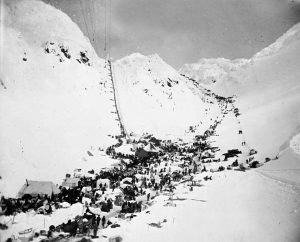 and family to travel up the Inside Passage to Skagway. They had gold on their minds, and the thought of going home rich was all they could think about. Most weren’t successful, and many didn’t make it there or back, but many went.
and family to travel up the Inside Passage to Skagway. They had gold on their minds, and the thought of going home rich was all they could think about. Most weren’t successful, and many didn’t make it there or back, but many went.
I don’t think this would be a trail I would want to be on in the winter, but it might be interesting in the summer months. There are many trails in the world that I would love to hike, but many of them I would probably only hike one time. I always find the history of the many trails that weren’t just for hiking originally, to be very interesting.
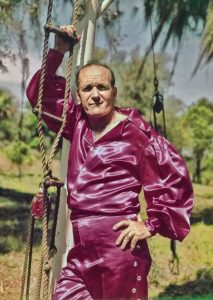 These days, we are all pretty used to stunt people who take wild chances to prove their prowess. It happens all the time. Whether it’s television stunts, circus stunts, or the daredevil stunts, they all have one thing in common…they live to show off their ability to perform these stunts under pressure…even if it costs them their lives, and it has. Many people have heard of Evel Knievel who was famous for jumping his motorcycle over everything. And then there were the car jumps on the Dukes of Hazard. But, really I think the circus was the real beginning of stunts. I could be wrong, but the tight rope walkers and the trapeze stunts, often without a net while a seemingly more tame version of stunt work, were still stunts and still dangerous.
These days, we are all pretty used to stunt people who take wild chances to prove their prowess. It happens all the time. Whether it’s television stunts, circus stunts, or the daredevil stunts, they all have one thing in common…they live to show off their ability to perform these stunts under pressure…even if it costs them their lives, and it has. Many people have heard of Evel Knievel who was famous for jumping his motorcycle over everything. And then there were the car jumps on the Dukes of Hazard. But, really I think the circus was the real beginning of stunts. I could be wrong, but the tight rope walkers and the trapeze stunts, often without a net while a seemingly more tame version of stunt work, were still stunts and still dangerous.
One stuntman, Karl Wallenda, born on January 21, 1905, was a German-American high wire artist, and a member of The Great Wallendas, with whom he began performing at the age of six. His family became a daredevil circus act which performed dangerous stunts, often without a safety net. They soon became world famous, and with fame came more and more difficulty of stunts, and more danger. Their stunts were exclusively high wire, and not trapeze, but they were elaborate and demanded the highest level of skill and bravery. I doubt if any stunt performer really thinks of their own demise very much, but I suppose it is a thought that must enter their minds periodically.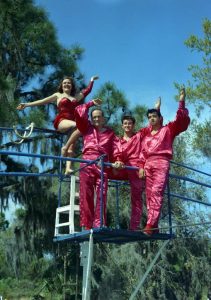
The Great Wallendas were famous throughout Europe for their four-man pyramid and cycling on the high wire. In 1928, Wallenda moved the act to the United States where they became The Flying Wallendas. There they performed in ever-increasingly difficult stunts, as freelancers. In 1947 they developed the unequaled three-tier 7-Man Pyramid. Karl Wallenda had the idea since 1938, but it took until 1946, when he and his brother Hermann developed it and had the right acrobats for it. Prior to that time, the Wallendas had been famous for the four-man pyramid and cycling on the high wire. In 1962, in Detroit, the Wallendas fell during a performance. Two members of the troupe were killed and Karl Wallenda’s son, Mario was paralyzed. Still, after such tragedies, the family determined that the show must always go on, usually after some regrouping. Another performer, Riette fell during a performance in Omaha, Nebraska, and was killed a year after the first tragedy. Karl decided not to continue that part of the act, but his daughter, Carla wanted the act, and after being told no, set out to perform it herself. When he saw her determination, Karl allowed her to have it, and she performed it without mishap. A made-for-TV movie about the family came out in 1978 and starred Karl Wallenda. The movie depicts the act’s comeback after a fatal accident involving several family members during 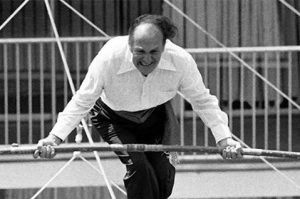 a performance. It looked like the great American comeback, but Wallenda was killed in a high wire accident in just 38 days after it was first broadcast. On March 22, 1978, Wallenda was attempting a walk between the two towers of the ten-story Condado Plaza Hotel in San Juan, Puerto Rico, on a wire stretched 121 feet above the pavement. The winds were high that day, and as a result that, and an improperly secured wire, he lost his balance and fell during the attempt. Wallenda’s face depicts the moment of realization and anguish when he knew that he was doomed. Wallenda was pronounced dead after his body arrived at the hospital. Karl Wallenda was 73 years old.
a performance. It looked like the great American comeback, but Wallenda was killed in a high wire accident in just 38 days after it was first broadcast. On March 22, 1978, Wallenda was attempting a walk between the two towers of the ten-story Condado Plaza Hotel in San Juan, Puerto Rico, on a wire stretched 121 feet above the pavement. The winds were high that day, and as a result that, and an improperly secured wire, he lost his balance and fell during the attempt. Wallenda’s face depicts the moment of realization and anguish when he knew that he was doomed. Wallenda was pronounced dead after his body arrived at the hospital. Karl Wallenda was 73 years old.

